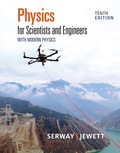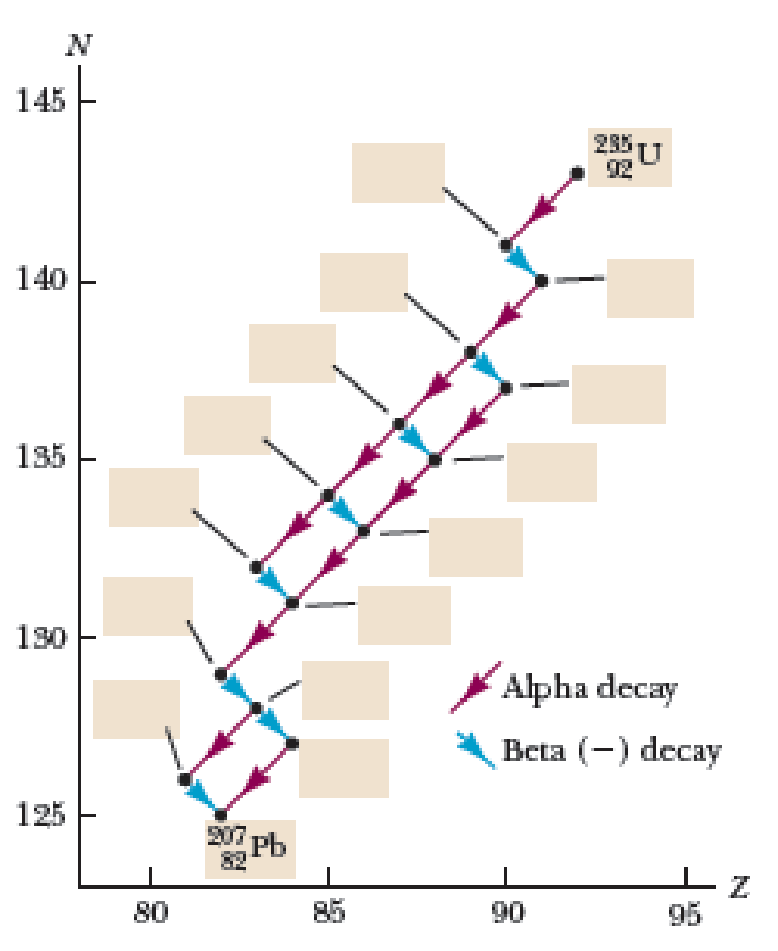
Physics for Scientists and Engineers with Modern Physics
10th Edition
ISBN: 9781337671729
Author: SERWAY
Publisher: Cengage
expand_more
expand_more
format_list_bulleted
Concept explainers
Textbook Question
Chapter 43, Problem 25P
Enter the correct nuclide symbol in each open tan rectangle in Figure P43.25, which shows the sequences of decays in the natural radioactive series starting with the long-lived isotope uranium-235 and ending with the stable nucleus lead-207.

Figure P43.25
Expert Solution & Answer
Trending nowThis is a popular solution!

Students have asked these similar questions
4. In the figure below what is the value of the angle 0?
A
30
PLEASE help with the experimental setup for this theory because i am so confused.
Part 2 - Geometry and Trigonometry
1. Line B touches the circle at a single point. Line A extends radially through the center of
the circle.
A
B
(a) Which line is tangential to the circumference of the circle?
(b) What is the angle between lines A and B.
2. In the figure below what is the angle C?
30
45
3. In the figure below what is the value of the angle 0?
30°
4. In the figure below what is the value of the angle 0?
A
30°
Chapter 43 Solutions
Physics for Scientists and Engineers with Modern Physics
Ch. 43.1 - Prob. 43.1QQCh. 43.5 - Prob. 43.3QQCh. 43.5 - Which of the following is the correct daughter...Ch. 43.8 - When a nucleus undergoes fission, the two daughter...Ch. 43.8 - Prob. 43.6QQCh. 43.10 - Prob. 43.7QQCh. 43 - Prob. 1PCh. 43 - Prob. 2PCh. 43 - Prob. 3PCh. 43 - Prob. 4P
Ch. 43 - Prob. 5PCh. 43 - Prob. 7PCh. 43 - Prob. 8PCh. 43 - Prob. 9PCh. 43 - Prob. 10PCh. 43 - Prob. 11PCh. 43 - Prob. 13PCh. 43 - Prob. 15PCh. 43 - Prob. 17PCh. 43 - Prob. 18PCh. 43 - Prob. 19PCh. 43 - Prob. 20PCh. 43 - Prob. 21PCh. 43 - Prob. 22PCh. 43 - Prob. 23PCh. 43 - Prob. 24PCh. 43 - Enter the correct nuclide symbol in each open tan...Ch. 43 - Prob. 26PCh. 43 - Prob. 27PCh. 43 - Prob. 28PCh. 43 - Prob. 29PCh. 43 - Prob. 30PCh. 43 - Prob. 32PCh. 43 - Prob. 33PCh. 43 - Prob. 35PCh. 43 - Prob. 37PCh. 43 - Prob. 39PCh. 43 - Prob. 41PCh. 43 - Prob. 42PCh. 43 - Prob. 44PCh. 43 - Prob. 45APCh. 43 - Prob. 46APCh. 43 - Prob. 47APCh. 43 - Prob. 48APCh. 43 - Prob. 49APCh. 43 - Prob. 50APCh. 43 - Prob. 51APCh. 43 - Prob. 52APCh. 43 - As part of his discovery of the neutron in 1932,...Ch. 43 - Prob. 55APCh. 43 - Prob. 56APCh. 43 - Prob. 58APCh. 43 - Prob. 59APCh. 43 - Prob. 60APCh. 43 - Prob. 62APCh. 43 - Prob. 63APCh. 43 - Prob. 64APCh. 43 - Prob. 65APCh. 43 - Prob. 66CP
Knowledge Booster
Learn more about
Need a deep-dive on the concept behind this application? Look no further. Learn more about this topic, physics and related others by exploring similar questions and additional content below.Similar questions
- Details solution No chatgpt plsarrow_forwardPlease solve and answer the problem correctly please.Thank you!!arrow_forwardWill you please walk me through the calculations in more detail for solving this problem? I am a bit rusty on calculus and confused about the specific steps of the derivation: https://www.bartleby.com/solution-answer/chapter-3-problem-15e-modern-physics-2nd-edition/9780805303087/7cf8c31d-9476-46d5-a5a9-b897b16fe6fcarrow_forward
- please help with the abstract. Abstract - This document outlines the format of the lab report and describes the Excel assignment. The abstract should be a short paragraph that very briefly includes the experiment objective, method, result and conclusion. After skimming the abstract, the reader should be able to decide whether they want to keep reading your work. Both the format of the report and the error analysis are to be followed. Note that abstract is not just the introduction and conclusion combined, but rather the whole experiment in short including the results. I have attacted the theory.arrow_forwardUsing the Experimental Acceleration due to Gravity values from each data table, Data Tables 1, 2, and 3; determine the Standard Deviation, σ, mean, μ, variance, σ2 and the 95% Margin of Error (Confidence Level) Data: Ex. Acc. 1: 12.29 m/s^2. Ex. Acc. 2: 10.86 m/s^2, Ex. Acc. 3: 9.05 m/s^2arrow_forwardIn the Super Smash Bros. games the character Yoshi’s has a “ground pound” down special move where he launches himself downward to attack an enemy beneath him. A) If Yoshi flings himself downwards at 9.76 miles per hour to hit an enemy 10.5 m below him, how fast is Yoshi traveling when he hits the enemy? 1 mile = 1609 m B) How much time does it take Yoshi to hit the enemy beneath him?arrow_forward
- No chatgpt pls will upvotearrow_forward1.62 On a training flight, a Figure P1.62 student pilot flies from Lincoln, Nebraska, to Clarinda, Iowa, next to St. Joseph, Missouri, and then to Manhattan, Kansas (Fig. P1.62). The directions are shown relative to north: 0° is north, 90° is east, 180° is south, and 270° is west. Use the method of components to find (a) the distance she has to fly from Manhattan to get back to Lincoln, and (b) the direction (relative to north) she must fly to get there. Illustrate your solutions with a vector diagram. IOWA 147 km Lincoln 85° Clarinda 106 km 167° St. Joseph NEBRASKA Manhattan 166 km 235° S KANSAS MISSOURIarrow_forwardPlz no chatgpt pls will upvotearrow_forward
arrow_back_ios
SEE MORE QUESTIONS
arrow_forward_ios
Recommended textbooks for you
 Physics for Scientists and Engineers with Modern ...PhysicsISBN:9781337553292Author:Raymond A. Serway, John W. JewettPublisher:Cengage Learning
Physics for Scientists and Engineers with Modern ...PhysicsISBN:9781337553292Author:Raymond A. Serway, John W. JewettPublisher:Cengage Learning Principles of Physics: A Calculus-Based TextPhysicsISBN:9781133104261Author:Raymond A. Serway, John W. JewettPublisher:Cengage Learning
Principles of Physics: A Calculus-Based TextPhysicsISBN:9781133104261Author:Raymond A. Serway, John W. JewettPublisher:Cengage Learning University Physics Volume 3PhysicsISBN:9781938168185Author:William Moebs, Jeff SannyPublisher:OpenStax
University Physics Volume 3PhysicsISBN:9781938168185Author:William Moebs, Jeff SannyPublisher:OpenStax Modern PhysicsPhysicsISBN:9781111794378Author:Raymond A. Serway, Clement J. Moses, Curt A. MoyerPublisher:Cengage Learning
Modern PhysicsPhysicsISBN:9781111794378Author:Raymond A. Serway, Clement J. Moses, Curt A. MoyerPublisher:Cengage Learning College PhysicsPhysicsISBN:9781938168000Author:Paul Peter Urone, Roger HinrichsPublisher:OpenStax College
College PhysicsPhysicsISBN:9781938168000Author:Paul Peter Urone, Roger HinrichsPublisher:OpenStax College Glencoe Physics: Principles and Problems, Student...PhysicsISBN:9780078807213Author:Paul W. ZitzewitzPublisher:Glencoe/McGraw-Hill
Glencoe Physics: Principles and Problems, Student...PhysicsISBN:9780078807213Author:Paul W. ZitzewitzPublisher:Glencoe/McGraw-Hill

Physics for Scientists and Engineers with Modern ...
Physics
ISBN:9781337553292
Author:Raymond A. Serway, John W. Jewett
Publisher:Cengage Learning

Principles of Physics: A Calculus-Based Text
Physics
ISBN:9781133104261
Author:Raymond A. Serway, John W. Jewett
Publisher:Cengage Learning

University Physics Volume 3
Physics
ISBN:9781938168185
Author:William Moebs, Jeff Sanny
Publisher:OpenStax

Modern Physics
Physics
ISBN:9781111794378
Author:Raymond A. Serway, Clement J. Moses, Curt A. Moyer
Publisher:Cengage Learning

College Physics
Physics
ISBN:9781938168000
Author:Paul Peter Urone, Roger Hinrichs
Publisher:OpenStax College

Glencoe Physics: Principles and Problems, Student...
Physics
ISBN:9780078807213
Author:Paul W. Zitzewitz
Publisher:Glencoe/McGraw-Hill
Half life | Radioactivity | Physics | FuseSchool; Author: FuseSchool - Global Education;https://www.youtube.com/watch?v=IDkNlU7zKYU;License: Standard YouTube License, CC-BY